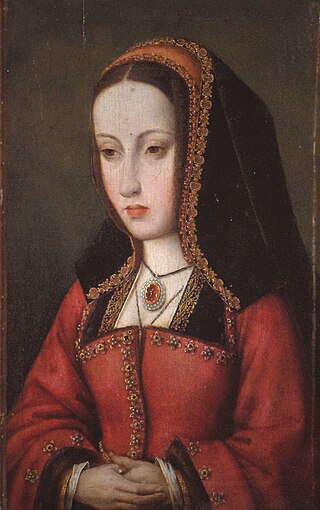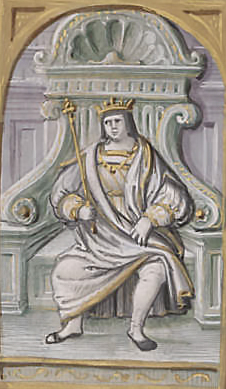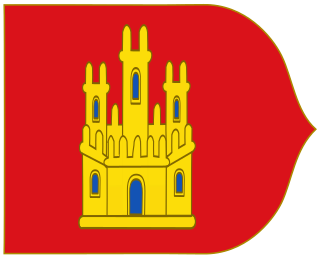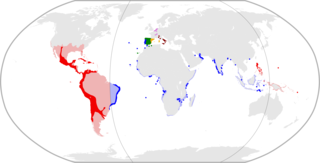Related Research Articles

Ferdinand IV of Castile called the Summoned, was King of Castile and León from 1295 until his death.

Joanna, historically known as Joanna the Mad, was the nominal queen of Castile from 1504 and queen of Aragon from 1516 to her death in 1555. She was the daughter of Queen Isabella I of Castile and King Ferdinand II of Aragon. Joanna was married by arrangement to the Austrian archduke Philip the Handsome on 20 October 1496. Following the deaths of her elder brother John, elder sister Isabella, and nephew Miguel between 1497 and 1500, Joanna became the heir presumptive to the crowns of Castile and Aragon. When her mother died in 1504, she became queen of Castile. Her father proclaimed himself governor and administrator of Castile.

Henry III of Castile, called the Suffering due to his ill health, was the son of John I and Eleanor of Aragon. He succeeded his father as King of Castile in 1390.

The Catholic Monarchs were Queen Isabella I of Castile and King Ferdinand II of Aragon, whose marriage (1475) and joint rule marked the de facto unification of Spain. They were both from the House of Trastámara and were second cousins, being both descended from John I of Castile; to remove the obstacle that this consanguinity would otherwise have posed to their marriage under canon law, they were given a papal dispensation by Sixtus IV. They married on October 19, 1469, in the city of Valladolid; Isabella was 18 years old and Ferdinand a year younger. It is generally accepted by most scholars that the unification of Spain can essentially be traced back to the marriage of Ferdinand and Isabella. Their reign was called by W.H. Prescott "the most glorious epoch in the annals of Spain".

The Kingdom of Castile was a large and powerful state on the Iberian Peninsula during the Middle Ages. Its name is popularly thought to come from the castles built in the region. It began in the 9th century as the County of Castile, an eastern frontier lordship of the Kingdom of León. During the 10th century, its counts increased their autonomy, but it was not until 1065 that it was separated from León and became a kingdom in its own right. Between 1072 and 1157, it was again united with León, and after 1230, this union became permanent. Throughout this period, the Castilian kings made extensive conquests in southern Iberia at the expense of the Islamic principalities. The Kingdoms of Castile and of León, with their southern acquisitions, came to be known collectively as the Crown of Castile, a term that also came to encompass overseas expansion.

The Crown of Aragon was a composite monarchy ruled by one king, originated by the dynastic union of the Kingdom of Aragon and the County of Barcelona and ended as a consequence of the War of the Spanish Succession. At the height of its power in the 14th and 15th centuries, the Crown of Aragon was a thalassocracy controlling a large portion of present-day eastern Spain, parts of what is now southern France, and a Mediterranean empire which included the Balearic Islands, Sicily, Corsica, Sardinia, Malta, Southern Italy and parts of Greece.

Henry IV of Castile, nicknamed the Impotent, was King of Castile and León and the last of the weak late-medieval kings of Castile and León. During Henry's reign, the nobles became more powerful and the nation became less centralised.

Álvaro de Luna y Fernández de Jarava, was a Castilian statesman, favourite of John II of Castile. He served as Constable of Castile and as Grand Master of the Order of Santiago. He earned great influence in the Crown's affairs in the wake of his support to John II against the so-called Infantes of Aragon. Once he lost the protection of the monarch, he was executed in Valladolid in 1453.

The House of Trastámara was a royal dynasty which first ruled in the Crown of Castile and then expanded to the Crown of Aragon in the late middle ages to the early modern period.

The Crown of Castile was a medieval polity in the Iberian Peninsula that formed in 1230 as a result of the third and definitive union of the crowns and, some decades later, the parliaments of the kingdoms of Castile and León upon the accession of the then Castilian king, Ferdinand III, to the vacant Leonese throne. It continued to exist as a separate entity after the personal union in 1469 of the crowns of Castile and Aragon with the marriage of the Catholic Monarchs up to the promulgation of the Nueva Planta decrees by Philip V in 1715.

The Council of Castile, known earlier as the Royal Council, was a ruling body and key part of the domestic government of the Crown of Castile, second only to the monarch himself.

María Alfonso Téllez de Meneses, known as María de Molina, was queen consort of Castile and León from 1284 to 1295 by marriage to Sancho IV of Castile, and served as regent for her minor son Ferdinand IV and later her grandson Alfonso XI of Castile (1312-1321).

Ferdinand II was King of Aragon from 1479 until his death in 1516. As the husband of Queen Isabella I of Castile, he was also King of Castile from 1475 to 1504. He reigned jointly with Isabella over a dynastically unified Spain; together they are known as the Catholic Monarchs. Ferdinand is considered the de facto first king of Spain, and was described as such during his reign, even though, legally, Castile and Aragon remained two separate kingdoms until they were formally united by the Nueva Planta decrees issued between 1707 and 1716.

The Cronista Rey de Armas in the Kingdoms of Spain was a civil servant who had the authority to grant armorial bearings. Currently this is no longer an office in Spain. The office of the King of Arms in Spain originated from those of the heralds (heraldos). In the early days of heraldry; anyone could bear arms, which led to disputes between individuals and families. These disputes were originally settled by the king, in the case of a dispute between nobles, or by a lower ranked official when the dispute involved non-nobles. Eventually, the task of settling these disputes was passed on to officers called heralds who were originally responsible for setting up tournaments and carrying messages between nobles.

Isabella I, also called Isabella the Catholic, was Queen of Castile from 1474 until her death in 1504. She was also Queen of Aragon from 1479 until her death as the wife of King Ferdinand II. Reigning together over a dynastically unified Spain, Isabella and Ferdinand are known as the Catholic Monarchs.
This is a list of some of the modern orders, decorations and medals of Spain.

Juan Núñez I de Lara y León, also known as "el Gordo" or "the Fat", was a Spanish noble. He was the head of the House of Lara, Lord of Lerma, Amaya, Dueñas, Palenzuela, Tordehumos, Torrelobatón, and la Mota. He was further known as Señor de Albarracín through his first marriage with Teresa Álvarez de Azagra.

The Battle of Lucena, also called Battle of Martín González, was a war event in which Christian forces of the Crown of Castile were faced against the Muslim forces of the Nasrid Emirate of Granada. It took place in the month of April of the year 1483, in the course of the Granada War, and in the course of it the Christian forces took Muhammad XII of Granada as prisoner.

The coat of arms of Castile was the heraldic emblem of its monarchs. Historian Michel Pastoureau says that the original purpose of heraldic emblems and seals was to facilitate the exercise of power and the identification of the ruler, due to what they offered for achieving these aims. These symbols were associated with the kingdom, and eventually also represented the intangible nature of the national sentiment or sense of belonging to a territory.

Pedro Fernández de Córdoba y Pacheco, first Marquess of Priego, was a Castilian nobleman. He became one of the most powerful men in Andalusia, but after the death of Queen Isabella I of Castile (1451–1504) supported her daughter Joanna of Castile (1479–1555) against King Ferdinand II of Aragon (1452–1516), who was regent of Castile. After serious disturbances in Córdoba in 1508 he was forced to throw himself on the king's mercy, and was arrested and exiled. Later he was pardoned and allowed to return.
References
- 1 2 3 4 5 6 Ladero Quesada, Miguel Ángel (1998). La Casa Real en la Baja Edad Media (in Spanish). Historia. Instituciones. Documentos No. 25. pp. 327–350.
- ↑ León-Borja, István Szászdi (2011). Juan Ponce de León y su época: estudios institucionales de la Conquista (in Spanish). Diputación de Valladolid. p. 136. ISBN 9788478523016.